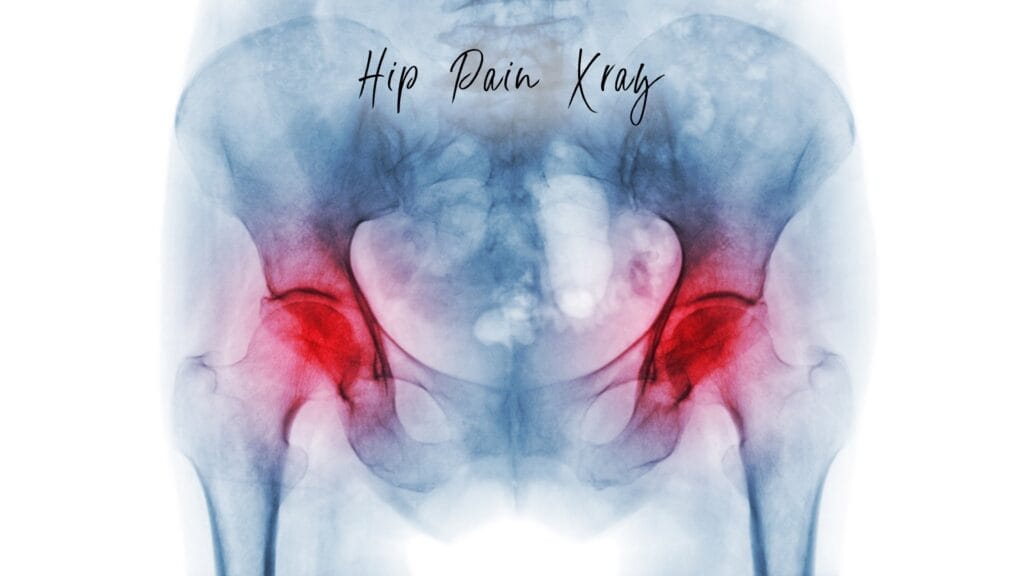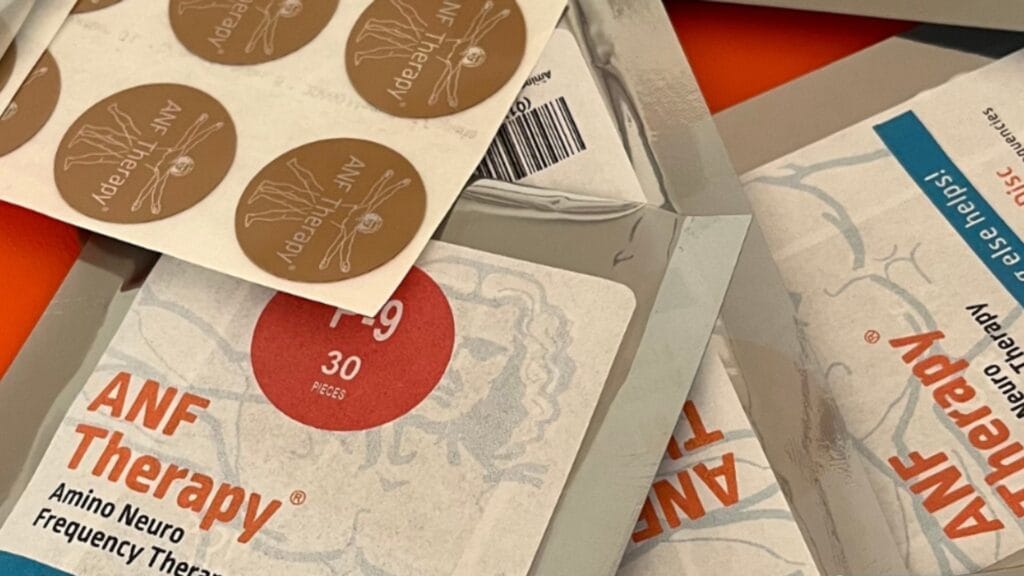
Table of Contents
Hip pain is a common issue that many people may experience at some point in their lives. It can occur anywhere around the hip joint and may result from ageing, sports injuries, or various medical conditions, such as arthritis.
Most of the time, when hip pain persists, doctors advise you to take multiple painkillers and sometimes invasive surgical procedures that can cause unwanted side effects. However, ANF Therapy®️ may be the best option if you are looking for a non-invasive and painless treatment approach. This therapy works on the principles of frequency medicine and uses ANF Devices that are charged with certain frequencies. It aims to activate the natural healing process of your body.
What is hip pain?
Hip pain is characterised as pain or discomfort around your hip joint. The hip joint is the largest ball and socket joint of your body and is involved in various movements, including walking, running, shifting your body weight, and balancing. It connects your thigh (femur) with the pelvis. Hip pain can occur in any part of your hip joint.
Hip pain is the most common symptom that can affect your daily activities and cause functional disability. The chances of hip joint increase by 30-40 per cent if you are an athlete. However, the chance of hip pain increases by 12-15% in people above 60 years old due to wear and tear.

What causes hip pain?
Hip pain is a symptom that various clinical conditions or sports injuries can cause. These include:
- Trauma to your hip joint
- Inflammation of tendons
- Trochanteric bursitis and iliopectineal bursitis
- Arthritis
- Developmental dysplasia of the hip joint
- Osteonecrosis
- Muscle strain
- Snapping hip syndrome
- Hamstring tear
- Sciatica
- Fibromyalgia
- Impingement of hip joint
Who is at risk of having hip pain?
The factors that make you more prone to hip pain include:
- Ageing
- Obesity
- Pregnancy
- Previous history of hip bone fracture
- Past surgical history of the hip joint
- Sedentary lifestyle
- Genetics
- Overuse of hip joint
- Bad posture
What are the symptoms of hip pain?
Hip pain symptoms can vary in intensity, ranging from mild to severe, depending on the underlying condition and its progression. The pain may occur during physical activities such as walking or climbing stairs and subside when you rest. In some cases, the pain can be persistent, affecting daily activities. Common symptoms of hip pain include:
- Stiffness in the hip joint or reduced range of motion in the hip joint
- Limping gait
- Pain or discomfort in the groin, thigh and buttocks area
- Pain that may radiate down to the knee
- Swelling or tenderness around the hip
- Worsening pain with specific movements or prolonged sitting
- Disruption of sleep due to discomfort or inability to find a comfortable position
Management of hip pain with ANF Therapy®️:
Multiple conditions can cause hip pain. Your ANF Therapist will take your detailed history and perform a physical and neurological examination to confirm the exact cause of your hip pain.
History:
Your ANF Therapist will clinically examine your hip joint to check for deformity, swelling, or tenderness in the affected area, range of motion at the hip joint, and gait. They may also perform the following tests:
FABER test: (Flexion abduction and external rotation)
In this test, your ANF Therapist will place you in a figure four position and apply pressure to your knee joint. This test is performed to check sacroiliac joint pathology.
FADIR test: (flexion, abduction and internal rotation).
This test is performed to identify impingement at the hip joint or labral tear in the hip joint.
Thomas test:
In this test, your ANF Therapist will assess your hip flexor tightness. They will ask you to lie supine, bring one leg to the chest, and the other remains extended.
Neurological examination:
In a neurological examination, your ANF Therapist will check your muscle strength, reflexes, and sensory sensations in your hip joint. They will assess which nerves are inflamed so they can apply devices accordingly.

Application of ANF Devices:
The ANF Devices are strategically applied to the affected area of your hip joint. These wearable devices are designed to alleviate pain in your hip and address the underlying causes of the discomfort. They work by reducing inflammation in the hip joint and surrounding tissues, thereby promoting natural healing. Additionally, the devices help strengthen your hip muscles, which further support the joint and enhance mobility.
Expected outcome:
According to Dr Mikel H-G Hoff, the founder of ANF Therapy®️, most patients feel an improvement in hip pain after a few minutes of applying ANF Devices. ANF Therapy®️ aims to reduce pain by 50% after the first session. However, response to ANF Therapy®️ may differ in different individuals, depending on the severity of the disease.
Follow-up:
Regular follow-ups are essential to treat hip pain and check the efficacy of ANF Devices. Your ANF Therapist will guide you on the number of follow-up sessions and treatment duration. You will need to change ANF Devices after 72 hours. Your therapist will create a personalised treatment plan for you and educate you about these changes.
Start your journey with ANF Therapy®️:
ANF Therapy®️ offers an innovative tool for managing hip pain. By utilising wearable ANF Devices that emit neurological frequencies, ANF Therapy®️ aims to modulate inflammatory responses, promote healing, strengthen your pelvic floor muscle and support overall well-being related to health. This non-pharmacological therapy provides a safe and effective approach that improves disease outcomes by targeting the root cause. If you’re suffering from hip pain, consult an ANF Practitioner or find an ANF Therapist at www.findanf.com to start your treatment with ANF Therapy®️ today!
If you’re a healthcare practitioner aiming to enhance your clinical skills with frequency medicine, learn more about the ANF Therapy®️ and ANF Clinical education program by visiting www.anfacademy.com.
How can I prevent hip pain?
You cannot prevent hip pain caused by injury or fracture. However, following these activities can reduce the likelihood of hip pain.
- Maintain your weight
- Warmup and stretch your muscles before the physics activity
- Do not play when you have pain
- Maintain a good posture
- Strengthen your core muscles
- Use proper footwear that supports your body
- Stay hydrated

FAQs:
What is the difference between hip pain and sciatica
If you have hip pain, you will feel pain in your groin area, which rarely radiates down to your legs. However, in sciatica, the pain will be more severe and may radiate down your thighs, legs, and toes.
Can I walk with hip pain?
Yes, you can walk with mild to moderate hip pain. Regular walking can help strengthen the muscles around your hip, improve flexibility, and keep you active. However, if the pain becomes persistent or worsens while walking, it’s essential to stop and rest because it may aggravate the condition.
How can I relieve hip pain at home?
You can relieve pain in your hip joint at home by following the RICE protocol and trying ANF Therapy®️. The RICE protocol for hip pain involves rest, icing, compressions, and elevation. ANF Therapy®️ is an advanced frequency therapy that treats various injuries by activating the natural healing process.
How to sleep with hip pain?
If you feel pain in your hip while sleeping, you can sleep on your back or place a pillow between your legs to lessen the pressure and keep your hips aligned. Avoid sleeping on the affected side of the hip joint.
Can ANF Therapy®️ help to reduce hip pain?
Yes, ANF Therapy®️ may be highly effective in managing hip pain. It uses wearable ANF Devices that help reduce inflammation in the hip joint and surrounding tissues, providing pain relief. Additionally, ANF Therapy®️ targets the underlying causes of the pain to promote natural healing and long-term recovery.
About ANF Therapy®️
ANF Therapy®️ uses circular ANF Devices, which are applied directly on the skin after palpation and assessment by a trained ANF Therapist following the ANF Therapy®️ Method, Patented Model no. U202030252, ES1259974.
The ANF Therapy®️ purpose is the alleviation of injury and pain within minutes.
Our aim is that the patient experiences a reduction of pain and swelling, an increase in range of motion, and an improvement in quality of life related to health. Non-transdermal, non-invasive device, NO needles or chemicals are used.
Do you need help with your health issues? Have you been experiencing symptoms of hip pain?
Contact us, and we will explain how we can help you!


